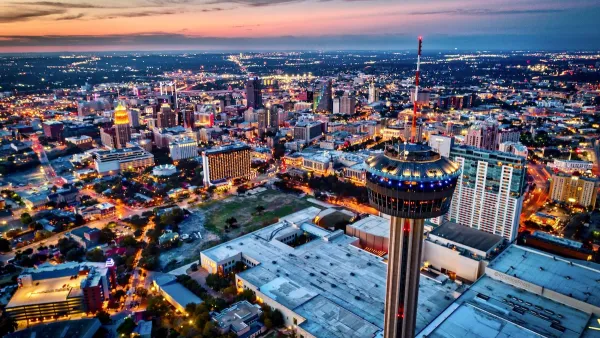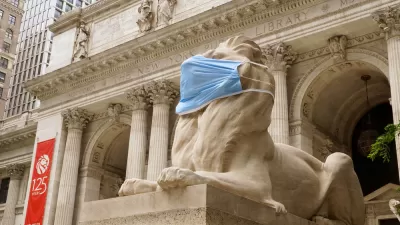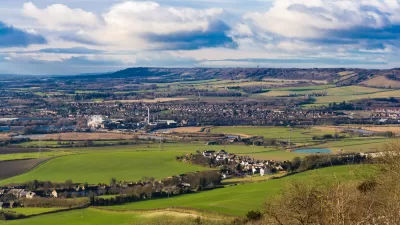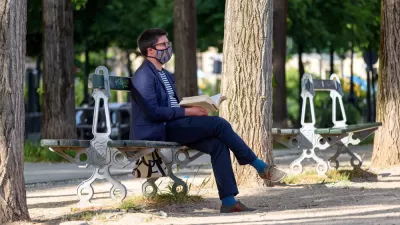2016 has produced an eclectic, imitative mix of titles to the urban library.

2016 is more than halfway done, but the year has already produced a bumper crop of books related to cities. This year, authors are exploring imaginative topics and focusing on micro-geographies. Cities are treated as neighborhoods (prosperous and otherwise), incubators for innovation, habitats for critters, and labyrinths for master criminals. Here are a few recently released titles I've been reading, in no particular order. Some may make Planetizen's Top Books list at the end of the year; some of them will not.
The Smartest Places on Earth: Why Rustbelts Are the Emerging Hotspots of Innovation
Akron, Albany, Minneapolis, Portland (Ore.), Raleigh-Durham: three of these things are not like the others. I'll read anything about how Rust Belt cities are on the rise. They have rich histories, great bones, and economic advantages (i.e., affordability) that coastal luxury cities and hipster upstarts may never have. I'd just like to read about cities that are actually in the Rust Belt. Instead, Agtmael and Bakker have chosen for their case studies a handful of disparate American cities (plus some in Europe) that have vaguely industrial pasts but, aside from Akron and maybe Albany, seem to offer few lessons that the Clevelands, Detroits, and Buffalos of the world can make use of.
Ghetto: The Invention of a Place, The History of an Idea
Initially promising as a survey of a seemingly politically incorrect concept that is crucial to the understanding of European and American cities alike (for different reasons),Ghetto is not so much about ghettos as it is a survey of scholarly conceptions of the notion of ghetto. Author Mitchell Duneier leads a tour of historical ghettos—starting with the Jewish ghettos of Europe and the Nazis demonization thereof—and extends to the present-day, with scholars like William Julius Wilson and activists like Geoffrey Canada. It is an intricate, erudite survey of sociological scholarship, with deep discussions about what African-American ghettos and Jewish ghettos do and do not share in common. But it is also not particularly accessible, with disappointingly scant relevance to public policy or the contemporary conception of marginalized urban enclaves.
The Human City: Urbanism for the Rest of Us
In which Joel Kotkin argues tediously that a) cities should favor families; and b) families should favor detached homes. For further reading, see my review in the California Planning & Development Report.
King and Queen of Malibu
What can urban planners learn from the origin story of a tiny, iconic, exclusive enclave on the edge of the Pacific? At first glance, very little. But it's still a great story, especially in the hands of author David Randall. Malibu wasn't so much founded as it was owned—by Frederick and May Rindge, a wealthy eccentric couple (he from Cambridge, Mass., she from Michigan) who made their mark on early 20th century Los Angeles in many ways. Where they didn't leave many marks was in Malibu, a 17,000-acre ranch that they bought in whole as their personal retreat from city life, such as it was in the 1910s. Suspicious and hermetic, the Rindges squabbled with squatters and even built a fake railroad above the seashore to prevent the state from building a precursor to the Pacific Coast Highway. After Frederick died in 1905, May took over the empire but, through some missteps, eventually lost control of the rancho. The highway arrived, May created the instant celebrity enclave Malibu Colony to raise revenue, and Malibu eventually became a city of its own, catering to people just as rich as the Rindges were, but in greater numbers. Despite the esoteric subject, it turns out there is a lesson for planners about coastal preservation, however inadvertent it may have been. As Randall mentions, albeit briefly, the Rindges' wealth and idiosyncrasies may have saved Malibu from development at a time when it would not have had the California Coastal Act to protect it. Debates over development in Malibu and along the whole coast rage on, but without the Rindges, there might be nothing left to debate over.
Evicted: Poverty and Profit in the American City
Evicted is a meticulous, conscientious account of the plague of evictions that pervade America's low-income communities. A seasoned scholar, Matthew Desmond embedded himself in Milwaukee to observe firsthand the experiences of landlords and residents, the latter teetering on the edge of financial ruin and the former teetering on the edge of what the law allows. Oddly, this approach—however earnest, dramatic, and even-handed it is—does not do the topic justice. Evicted examines the ways that eviction affects lives, but, much like Behind the Beautiful Forevers, Katherine Boo's firsthand account of the slums of Mumbai, it does so almost with pornographic intensity and even a glimmer of exploitation. As a primary source, though, Evicted is masterful, telling stories that, though we can likely imagine them, generally do not get told because of the marginalization of the victims of eviction and the furtiveness of the evictors. What Evicted lacks are the statistics and policy analyses to explain how housing in America became so fraught. Sadly, it's not hard to imagine how difficult the lives of many Americans are. What's hard is figuring out what we need to do about it. Desmond discusses policy and nationwide statistics in his epilogue. But it feels too late for that. Even with Desmond's heartfelt stories, Milwaukee is still burning and millions of Americans live in fear of life out on the street.
Streetfight: Handbook for an Urban Revolution
The trouble with Streetfight is that is far more fun to visit New York and enjoy Jeanette Sadik-Khan's handiwork than it is to read about it. It's not that Streetfight isn't well written. It's engaging and insightful and a powerful affirmation of contemporary planning principles that, broadly construed, favor humans over automobiles. Even so, it rehashes debates and triumphs, like pedestrian plazas and bike lanes, that are already well known in planning circles, Sadik-Kahn being one of the most famous personalities in contemporary planning (and a combative one too, sometimes unnecessarily so). More than anything else, she exemplifies the value of self-promotion: a planning official who is not afraid to expose herself and "fight" for her plans — even in the face of some unhinged opposition — can accomplish a great deal. Then again, though it includes some key insights—Sadik-Kahn is all about quantitative analysis, even for interventions that seem to transcend data—Streetfight isn't so much a "handbook" as it is an inspiration. As Sadik-Khan acknowledges, local activists and officials always have to adapt to their local cultures, regulations, and built environments. So it's hard to tell whether a personality that can make it in New York would make it in any town that is less toddling.
Where We Want to Live: Reclaiming Infrastructure for a New Generation of Cities
Atlanta local hero Ryan Gravel sandwiches a dull, bureaucratic story about the creation of the Atlanta Beltline between unexpectedly eloquent and passionate discussions about the importance of urban infrastructure and shared spaces. Given how parochial planning can be, one out of two isn't bad. Predictably, the story about the Belt Line—a 1,300-acre network of trails and open spaces encircling central Atlanta that was, like its obvious cousin the High Line, carved out of a railroad right of way—involves a lot of local politics and politicking. Gravel is the star of that show, doggedly pursuing the project for the better part of two decades. And counting. Early phases have opened, with many more to go. In the book's opening and closing thirds, Gravel explains why he cares so deeply about the Beltline and other urban infrastructure projects, waxing poetic about everything from Parisian streets to Houston's Buffalo Bayou Park to the proposed transformation of the Los Angeles River. He convincingly argues that careful but enthusiastic investing in infrastructure, whether it's the type that brings beauty and joy or just gets people where they need to go (ideally without relying 100 percent on autos), is crucial for economic development, equity, inclusion, and well-being.
This is Where You Belong
At first blush, you'd think that a how-to guide that tells people how to be good neighbors and how to enjoy the places where they live sounds too stupid even for an Idiot's Guide, much less a volume from a major press. Then again, This is Where You Belong should be required reading for many Americans. Melody Warnick's thesis, inspired by her own experience of moving to Blacksburg, Va., is that many Americans, especially those who involuntarily move to places because of jobs or other influences, are often indifferent or even hostile to the communities where they end up. Unfortunately, transplanted families sometimes never feel at home, especially when entire neighborhoods are filled with embittered families that want nothing to do with the world beyond their front lawns. Warnock provides a primer for exploring, engaging, and appreciating America—at least from the perspective of a white middle class family that has landed in someplace as charming (if initially foreign to Warnick) as Blacksburg. It's hard to tell whether Warnick is being ironic but, taken at face value, she offers reasonable lessons for how, and why, residents should walk around, discover local businesses, meet their neighbors, and get involved with civic life. Each chapter even includes a handy list of resources like local organizations, events, and tips for DIY urbanism. Underlying all of it is an ebullient message encouraging families not just to appreciate their places but also each other. Ideally, we shouldn't need that message, but it's good to hear it every so often.
The Road Taken
The latest of umpteen books by celebrity civil engineer Henry Petroski, The Road Taken promises to be a comprehensive analysis of how America's infrastructure has deteriorated. Instead, it's a meandering hodgepodge of discussions about different types of infrastructure and the histories behind them. The book isn't unentertaining. It just doesn't seem to have a point, which is a shame given the enormity of the crisis we are facing.
Dream Cities: Seven Urban Ideas that Shape the World
I'm still having trouble making sense of Dream Cities. The premise is great: choose a handful of architectural typologies and associated major architects and evaluate them in both stylistic and urbanist terms, explaining how they reflect and contribute to conceptions of urbanism over time. Typologies include castles, monuments, habitats, and malls. They also include "corals," which like overly poetic metaphor for mixed-use communities (and one that contradicts his title—I'm pretty sure corals preceded cities, by a few million years). Architects include mainly heavy-hitters: Corbu, Wright, Jerde, Foster, Duany. That's fine, but it's hard to agree that Graham is "show[ing] how to see the world in a new way." The first chapter, about castles and early-20th-century architect Bertram Godhue, is particularly befuddling. Graham spends one sentence in medieval Spain and then jumps to the present day. He doesn't actually discuss the history of castles, so it's impossible to understand what he's getting at with Goodhue's revivalist designs. His chapters on malls (Jerde, etc.) is stronger, while it turns out that "corals" is a rehash of progressive contemporary planning as inspired by Jane Jacobs (whom Graham cities heavily). Dream Cities is a fun romp at times; it just doesn't live up to its own dreams about itself.
A Burglar's Guide to the City
Most books on urban crime assume that crime is a bad thing. Author Geoff Manaugh, well known as the author of Bldgblog.com, takes a somewhat different tack. He doesn't exactly endorse bank heists and cat burglary, but he is genuinely impressed by the knowledge and skills that many of history's more inventive criminals use to pull off their crimes. His premise is fairly high-concept: let's look at a city the way a criminal sees it. Buildings are not shelters; they are targets. Blueprints are not guides; they're maps. Storm drains and streets aren't infrastructure; they are escape routes. Manaugh focuses largely on Los Angeles, which, true to its noir reputation, is known as the bank robbery capital of the world, what with all those ten-lane escape routes. In many instances, it seems like Manaugh is stretching a little too far. How many master criminals are there, really? And shouldn't cities focus more on gang members than on catburglars? But A Burglar's Guide offers a relatively lighthearted (without being flippant), original perspective on what is otherwise a scourge. It's also a refreshing change from the ponderous, often disingenuous, concerns we hear about "safety" and "security" in the age of terrorism.

Planetizen Federal Action Tracker
A weekly monitor of how Trump’s orders and actions are impacting planners and planning in America.

Chicago’s Ghost Rails
Just beneath the surface of the modern city lie the remnants of its expansive early 20th-century streetcar system.

San Antonio and Austin are Fusing Into one Massive Megaregion
The region spanning the two central Texas cities is growing fast, posing challenges for local infrastructure and water supplies.

Since Zion's Shuttles Went Electric “The Smog is Gone”
Visitors to Zion National Park can enjoy the canyon via the nation’s first fully electric park shuttle system.

Trump Distributing DOT Safety Funds at 1/10 Rate of Biden
Funds for Safe Streets and other transportation safety and equity programs are being held up by administrative reviews and conflicts with the Trump administration’s priorities.

German Cities Subsidize Taxis for Women Amid Wave of Violence
Free or low-cost taxi rides can help women navigate cities more safely, but critics say the programs don't address the root causes of violence against women.
Urban Design for Planners 1: Software Tools
This six-course series explores essential urban design concepts using open source software and equips planners with the tools they need to participate fully in the urban design process.
Planning for Universal Design
Learn the tools for implementing Universal Design in planning regulations.
planning NEXT
Appalachian Highlands Housing Partners
Mpact (founded as Rail~Volution)
City of Camden Redevelopment Agency
City of Astoria
City of Portland
City of Laramie





























